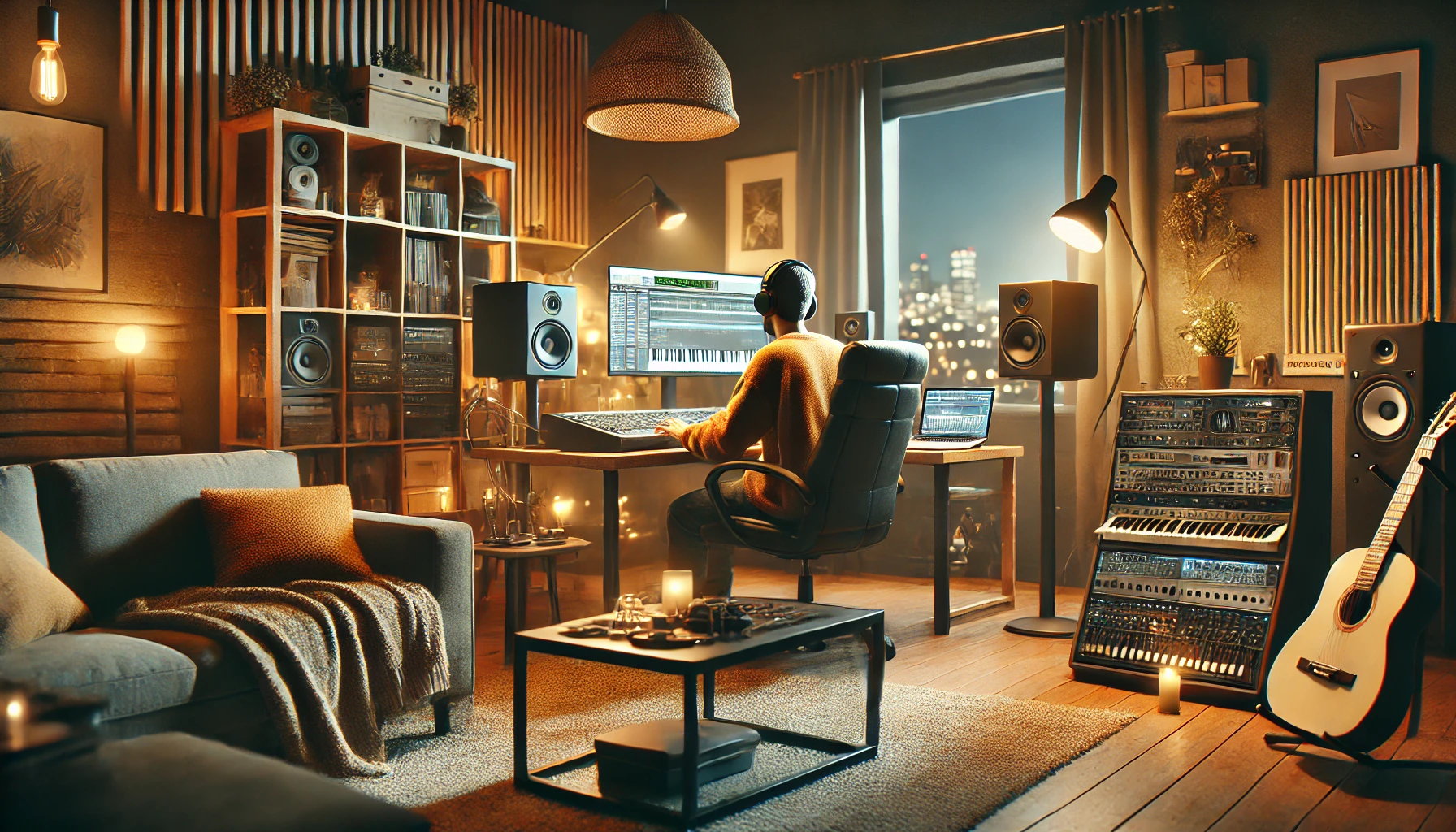Lifestyle
Lifestyle in Home Studio Session: Create, Work, and Thrive in Your Own Space

Lifestyle in Home Studio Session
Introduction to Home Studio Lifestyle
A home studio is a creative space where people work on music, photography, podcasts, or other artistic projects. It offers freedom, comfort, and full control over the creative process. Many artists, photographers, and content creators prefer working from home instead of renting a professional studio.
Home studio lifestyle means balancing work, creativity, and personal life in the same space. It allows flexibility, helping people stay productive without following strict schedules. Whether recording a song, shooting lifestyle photos, or creating digital content, a home studio makes everything possible without stepping outside.
What Does ‘Home Studio Lifestyle’ Entail?
A home studio is more than just a place. It is a way of living. Many people set up small studios in bedrooms, basements, or even living rooms. It becomes a personal space that reflects creativity and personality.
Musicians record songs at home without expensive equipment. Photographers use natural light for amazing lifestyle sessions. Video creators shoot high-quality content without renting a professional studio. A home studio gives control over time, creativity, and production without any outside pressure.
Why More Individuals Are Embracing Home Studios?
The trend of home studios is growing fast. More people choose to work from home instead of going to traditional workplaces. There are several reasons for this shift:
- Cost-Effective: Renting a studio is expensive. Setting up a small studio at home saves money.
- Comfort: Home is a familiar place. Working in a relaxed environment boosts creativity.
- Flexibility: No need to follow a fixed schedule. People work at their own pace.
- Personalization: A home studio reflects individual style. It creates a better work atmosphere.
- Technology: High-quality cameras, microphones, and software make it easy to create professional work at home.
The home studio lifestyle is perfect for artists, musicians, and photographers. It allows them to focus on creativity without worrying about external factors. Many famous musicians, photographers, and content creators started their journey in home studios. Today, they inspire many people to follow the same path.
A home studio is more than just a trend. It is the future of creative work. Many people love this lifestyle because it brings freedom, flexibility, and productivity. Anyone with passion and creativity can build a home studio and turn their dreams into reality.
Advantages of Home Studio Sessions
Home studio sessions bring many benefits. They offer comfort, flexibility, and full creative control. Many artists, musicians, photographers, and content creators prefer working in a home studio. It is a simple setup that helps people work efficiently without stress.
Comfort and Convenience: The Appeal of Familiar Surroundings
A home studio allows work in a personal space. There is no need to travel or adjust to a new environment. Everything is set up the way the artist wants. This helps creativity flow naturally.
Familiar surroundings bring comfort. There are no outside distractions. People can focus on work without interruptions. A home studio allows flexible hours. Work happens at the best time, whether day or night.
A relaxed space leads to better performance. Musicians record with ease. Photographers capture natural moments. Content creators make videos without feeling rushed. The home studio lifestyle provides the best work environment for creativity.
Personalization: Infusing Individual Style into the Studio Environment
A home studio reflects personal style. Every setup is unique. Some prefer a minimal look, while others like a colorful and vibrant space. The best part is full control over the setup.
Musicians arrange instruments and recording gear for easy access. Photographers set up lighting and props to match their vision. Video creators adjust backgrounds for different content styles. A home studio adapts to changing needs.
The environment affects creativity. A customized space brings inspiration. Work becomes enjoyable. A home studio is not just a workspace—it is a place that fuels passion and expression.
Cost-Effectiveness: Financial Benefits of Home-Based Studios
A home studio saves money. Renting a professional studio is expensive. Setting up a studio at home cuts costs. There are no travel expenses. Everything needed is in one place.
Many artists start with basic equipment. Over time, they upgrade. A home studio grows with the creator. There is no pressure to spend a lot. High-quality work is possible with minimal investment.
Technology makes home studio sessions affordable. Modern software and tools allow professional-quality work without expensive equipment. This makes it easier for beginners to start and professionals to expand.
The home studio lifestyle is practical. It offers creative freedom, cost savings, and a comfortable work environment. Many professionals choose this setup for long-term success.
Setting Up an Effective Home Studio
Creating a home studio requires planning. The right equipment, space setup, and sound quality make a big difference. Whether for music, photography, or content creation, a well-designed studio improves work quality. A home studio should be comfortable, functional, and inspiring.
Essential Equipment: Must-Have Tools for Success
The right equipment depends on the type of work. Musicians need recording gear, photographers need cameras, and content creators need lighting and video tools. Basic equipment for a home studio includes:
For Musicians and Audio Recording:
- Microphone – Captures clear sound
- Audio Interface – Connects instruments and microphones to a computer
- Studio Headphones – Helps with sound accuracy
- Digital Audio Workstation (DAW) – Software for recording and editing
- Studio Monitors – Provides accurate sound playback
For Photographers and Videographers:
- Camera – High-resolution for clear images and videos
- Tripod – Keeps the camera steady
- Lighting Kit – Improves visibility and enhances shots
- Backdrop – Creates a clean background for shoots
- Editing Software – Helps refine photos and videos
For Content Creators and Podcasters:
- Microphone and Pop Filter – Ensures clear voice recording
- Webcam or DSLR – High-quality video capture
- Lighting Setup – Enhances video quality
- Editing Software – Edits podcasts and videos for a professional touch
A home studio does not need expensive equipment to start. Many professionals upgrade gear over time. The most important part is having the right tools to match creative needs.
Space Optimization: Making the Most of Limited Areas
Not everyone has a large room for a studio. A small space can work with proper organization. The goal is to create a functional, distraction-free area.
- Choose a Quiet Spot – Avoid places with outside noise
- Declutter the Area – Keep only necessary items
- Use Wall Space – Install shelves for storage
- Foldable or Multi-Use Furniture – Saves space when not in use
- Proper Desk Setup – Keeps equipment organized
Many home studios fit in a corner, spare room, or even a closet. The right layout makes a small space feel bigger. A well-organized studio boosts focus and creativity.
Acoustic Considerations: Enhancing Sound Quality in Home Studios
Sound quality is important for home studios. A quiet and echo-free space improves recordings. Musicians, podcasters, and content creators benefit from good acoustics.
- Use Soundproofing Materials – Thick curtains, carpets, and foam panels reduce noise
- Position Furniture Wisely – Bookshelves and rugs absorb sound reflections
- Avoid Empty Walls – Large bare walls create echoes
- Isolate the Microphone – Use a pop filter and isolation shield for clear recordings
- Adjust Speaker Placement – Keeps sound balanced in the room
Good acoustics make recordings sound professional. Even a simple setup can improve sound quality with the right adjustments.
Lifestyle Photography in Home Studios
Lifestyle photography captures real-life moments in a natural way. Unlike traditional studio photography, it focuses on emotions, everyday activities, and authentic expressions. A home studio is a perfect place for this style because it provides a personal, comfortable setting. Many photographers prefer home studios for their flexibility and unique storytelling potential.
Capturing Authentic Moments: The Essence of Lifestyle Photography
Lifestyle photography is about real moments, not forced poses. It tells a story through natural expressions, movements, and interactions. The goal is to capture emotions as they happen.
Photographers use home settings to create a relaxed environment. This makes people feel comfortable, leading to genuine expressions. Whether it’s a family spending time together, an artist working in their studio, or a simple morning routine, lifestyle photography turns everyday moments into art.
Key elements of capturing authentic moments:
- Candid Shots – Avoid forced poses, capture natural expressions
- Soft Natural Light – Use windows for a warm, natural glow
- Movement and Interaction – Encourage natural actions, like playing, laughing, or working
- Minimal Editing – Keep colors and tones true to real life
A home studio allows complete creative freedom. There is no need for artificial backdrops or staged settings. Every home has a unique charm that adds personality to the photos.
Preparing Your Home: Tips for a Successful In-Home Session
A well-prepared home studio improves photo quality. The right setup ensures the best lighting, background, and comfort for the subjects.
- Choose the Best Location – A bright room with large windows works well
- Declutter the Space – A clean, simple background keeps the focus on the subject
- Use Natural Light – Open curtains, avoid harsh artificial lights
- Add Cozy Elements – Blankets, books, plants, and candles make the space warm and inviting
- Set the Mood – Soft music, comfortable seating, and a relaxed atmosphere help subjects feel at ease
A home should not feel like a studio. It should look lived-in, warm, and personal. This creates an environment where natural moments happen effortlessly.
Incorporating Personal Elements: Showcasing Individuality in Photos
A home studio gives the advantage of personal touches. Personal objects, decorations, and everyday items make photos unique.
Ways to add personal elements:
- Use Meaningful Props – Favorite books, musical instruments, or art supplies
- Highlight Everyday Activities – Reading, cooking, playing with pets
- Incorporate Family Heirlooms – Old furniture, vintage items, or handmade decorations
- Include Personal Style – Clothes, accessories, and home decor reflect individuality
These small details tell a story. A musician in their home studio, an artist painting in their workspace, or a family enjoying a cozy afternoon—these moments feel real and timeless.
Lifestyle photography in a home studio is all about storytelling. It is simple, natural, and meaningful. Every home has a story, and a well-planned home studio session brings that story to life.
Home Recording Studio Lifestyle
The home recording studio lifestyle is becoming more popular. Musicians, podcasters, and content creators prefer home studios for their flexibility, comfort, and cost-effectiveness. With modern technology, high-quality recordings are possible without expensive studio rentals. A well-organized home recording studio provides creative freedom while maintaining professionalism.
The Evolution of Home Recording: From Analog to Digital
Home recording has changed a lot over the years. In the past, professional studios used analog equipment, which was expensive and complex. Musicians had to rent studio time, limiting their creative control.
Now, digital technology has made recording easier. With a laptop, audio interface, and good microphone, artists can produce studio-quality sound from home. Digital Audio Workstations (DAWs) like Ableton, FL Studio, and Pro Tools have replaced bulky analog setups.
Key advancements in home recording:
- Affordable Equipment – High-quality microphones, headphones, and soundproofing options at lower costs
- Portable Studios – Laptops and compact recording gear allow flexibility
- Cloud Storage and Collaboration – Artists work remotely with producers and musicians worldwide
- AI and Plugins – Digital tools enhance sound quality and mix tracks professionally
Digital home studios allow independent artists to create, edit, and release music without needing a big budget. Many successful musicians started in home studios before moving to professional setups.
Balancing Work and Leisure: Maintaining Productivity in a Home Studio
A home studio offers freedom, but it also requires discipline. Working in the same space where you relax can be challenging. Without structure, distractions reduce productivity.
Tips for balancing work and leisure in a home recording studio:
- Set a Schedule – Allocate specific hours for recording and breaks
- Create a Separate Work Area – Keep the studio space dedicated to work
- Use Time Blocks – Record, edit, and mix in separate sessions to stay focused
- Take Short Breaks – Avoid ear fatigue and maintain creativity
- Keep the Studio Organized – A clutter-free space boosts efficiency
Maintaining a balance ensures consistent productivity without feeling overwhelmed. A well-structured routine helps musicians and content creators stay creative while avoiding burnout.
Challenges and Solutions: Overcoming Common Home Studio Hurdles
Setting up and maintaining a home recording studio comes with challenges. Common issues include noise problems, technical difficulties, and motivation struggles.
Common home studio problems and solutions:
- External Noise – Traffic, neighbors, and household sounds can ruin recordings.
Solution: Use soundproofing foam, heavy curtains, and noise reduction software. - Room Acoustics – Echoes and poor sound quality affect recording.
Solution: Add carpets, bookshelves, and foam panels to absorb sound reflections. - Lack of Inspiration – Working alone in a home studio can feel isolating.
Solution: Connect with other artists online, take creative breaks, and explore new techniques. - Technical Issues – Software crashes, latency problems, and equipment malfunctions.
Solution: Keep software updated, invest in quality gear, and learn basic troubleshooting. - Distractions – Home environments have many interruptions.
Solution: Set clear boundaries with family and friends, use noise-canceling headphones, and stay disciplined with work hours.
A home recording studio is a long-term investment in creativity. With the right setup, mindset, and problem-solving approach, it becomes a productive and inspiring space. Many independent artists and content creators have built successful careers from home studios. The lifestyle offers control, comfort, and endless possibilities.
Case Studies: Success Stories from Home Studios
Many successful artists, musicians, and photographers started their careers in home studios. With limited resources, they created high-quality work that gained worldwide recognition. These stories prove that a home studio can be just as powerful as a professional setup.
Musicians Who Thrived with Home Recordings
The home recording studio lifestyle has helped many musicians produce hit songs and albums. Advances in technology have made it possible to create, mix, and master music at home. Some of the most famous musicians started recording in small, DIY setups before reaching mainstream success.
Billie Eilish & Finneas
- Billie Eilish and her brother, Finneas, recorded her Grammy-winning album When We All Fall Asleep, Where Do We Go? entirely in their childhood home.
- Their home studio setup included a basic laptop, a microphone, and minimal equipment.
- This success proved that creativity matters more than expensive studio gear.
Tame Impala (Kevin Parker)
- Kevin Parker, the mastermind behind Tame Impala, records, produces, and mixes all his music in his home studio.
- His psychedelic rock sound, produced from a small home setup, has won multiple awards and international acclaim.
Chance the Rapper
- Chance the Rapper created his breakthrough mixtape Acid Rap using a home studio.
- Without a record label, he self-released his music online, gaining millions of fans.
- His success showed that independent artists can build careers without expensive studios.
These musicians prove that talent and creativity are more important than big-budget recording spaces. A home studio allows full artistic control and freedom to experiment without industry pressures.
Photographers Creating Magic in Domestic Settings
Lifestyle photography in home studios has become a powerful trend. Many photographers create stunning images using natural light and simple setups. These photographers turned their homes into creative spaces and built successful careers.
Jenna Kutcher
- Jenna Kutcher started as a wedding photographer but later embraced lifestyle photography in her home studio.
- She uses simple backgrounds, cozy home settings, and natural light to create warm, authentic images.
- Her work focuses on storytelling through real-life moments.
Brandon Woelfel
- Brandon Woelfel is famous for his unique editing style and use of lighting in home settings.
- He transforms ordinary spaces into magical photography backdrops with fairy lights and creative props.
- His work shows that home photography can look professional with the right vision.
Alex Strohl
- Alex Strohl blends adventure and lifestyle photography, often using his home studio as a creative hub.
- His photography focuses on natural elements, cozy indoor settings, and real-life interactions.
- He proves that a home studio can be a storytelling tool rather than just a workspace.
Many successful photographers started with basic setups at home. They used everyday surroundings to create powerful images. Their work proves that creativity is more important than location.
Key Takeaways from These Success Stories:
- A home studio provides complete creative control.
- High-quality work is possible with minimal equipment.
- Passion and consistency lead to success, no matter the workspace.
- Many successful artists started small and built their careers from home.
The home studio lifestyle offers endless possibilities. Whether in music or photography, creativity thrives in personal spaces. These success stories inspire many to start their journey from home, proving that big dreams can begin in small spaces.
Tips for Enhancing Your Home Studio Lifestyle
A home studio offers freedom, creativity, and convenience, but it also requires discipline and growth. Managing time, learning new skills, and connecting with a community can improve both productivity and creativity. These tips help artists, musicians, and photographers make the most of their home studio lifestyle.
Time Management: Structuring Your Day for Optimal Creativity
Working in a home studio requires a good routine. Without structure, distractions take over, and productivity drops. The best way to stay focused is to create a schedule that supports creativity.
Tips for Better Time Management:
- Set Work Hours – Define when to create, record, or edit. A routine builds consistency.
- Use Time Blocks – Break the day into focused work sessions with short breaks. This improves concentration.
- Limit Distractions – Keep the studio space free from unnecessary interruptions like social media and TV.
- Prioritize Tasks – Start with the most important project. Finish small tasks later.
- Take Breaks – Short breaks refresh the mind and prevent burnout.
A well-structured day allows artists to stay productive without feeling overwhelmed. Balance is key to long-term success.
Continuous Learning: Staying Updated with Industry Trends
The creative industry changes quickly. New recording techniques, photography styles, and editing tools appear often. Staying updated helps home studio professionals stay competitive and improve their skills.
Ways to Keep Learning:
- Follow Online Tutorials – Platforms like YouTube and Skillshare offer free and paid lessons on music production, photography, and editing.
- Read Blogs and Magazines – Websites like Sound on Sound, PetaPixel, and DIY Musician provide industry updates.
- Experiment with New Techniques – Trying different camera settings, lighting methods, or mixing styles keeps work fresh.
- Take Online Courses – Learning from professionals speeds up skill improvement.
- Watch Interviews and Podcasts – Listening to industry experts provides valuable insights.
Growth happens through continuous learning. The best home studio professionals stay curious and always look for ways to improve their craft.
Community Engagement: Connecting with Fellow Home Studio Enthusiasts
A home studio can feel isolating. Unlike professional studios where people interact daily, working alone may limit creative feedback and motivation. Connecting with other artists, musicians, and photographers provides support and inspiration.
Ways to Build a Creative Network:
- Join Online Communities – Facebook groups, Reddit forums, and Discord servers bring together home studio professionals.
- Attend Virtual and Local Meetups – Industry events, photography walks, and music production workshops help build relationships.
- Collaborate with Other Creators – Working with others leads to new ideas and opportunities.
- Share Work on Social Media – Platforms like Instagram, TikTok, and YouTube showcase talent and attract like-minded people.
- Seek Feedback – Honest opinions from peers improve work quality.
A strong creative community helps artists stay motivated and discover new opportunities. Sharing experiences with others makes the home studio lifestyle more enjoyable and fulfilling.
Conclusion
Embracing the Home Studio Lifestyle: Final Thoughts and Encouragement
The home studio lifestyle is more than just a trend—it is a way of working that gives creative freedom, flexibility, and control. Whether recording music, capturing lifestyle photography, or producing content, a home studio allows artists to work in a comfortable and personal space.
Many successful musicians, photographers, and content creators started from home studios with minimal equipment. They proved that creativity and passion matter more than expensive setups. Technology has made professional-quality work possible from any home environment, making it easier than ever to follow artistic dreams.
Building and improving a home studio takes time. It requires patience, dedication, and continuous learning. Challenges will come, but smart problem-solving and a strong creative network help overcome them.
Key Takeaways:
- A home studio offers comfort, flexibility, and cost savings.
- Success comes from discipline, good time management, and continuous learning.
- Great work is possible with basic equipment and creativity.
- Connecting with a community of like-minded individuals boosts motivation.
The home studio lifestyle is perfect for those who want control over their creative journey. Whether just starting or looking to improve an existing setup, every step brings new opportunities.
Anyone can build a successful career from a home studio with passion and commitment. The most important thing is to start, experiment, and enjoy the creative process. The home studio lifestyle is not just about work—it is about living creatively and doing what you love every day.
Thank you for visiting our blog! If you enjoyed this post, feel free to check out more interesting and helpful content here.
-

 Law & Personal Injury6 days ago
Law & Personal Injury6 days agoHow to File a Sample Complaint for Sanctions Against an Attorney in Illinois
-

 Entertainment1 week ago
Entertainment1 week agoAura of Vitality 5e: A Complete Guide to Healing and Support in Combat
-

 Fashion1 week ago
Fashion1 week agoWhat are the Differences Between Microlocs vs Sisterlocks?
-

 Entertainment6 days ago
Entertainment6 days agoKamryan Randolph Wrestling: The Journey of a Rising Star in Sports
















